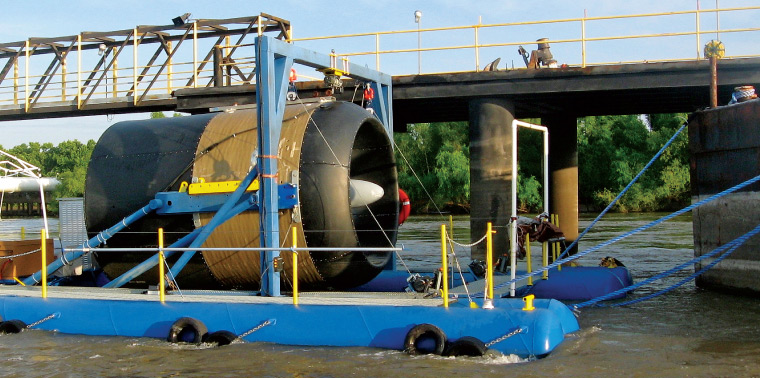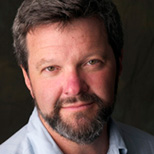April 17, 2013 — On a fast-moving stretch of the Mississippi River in downtown Minneapolis, a 9.2-megawatt hydroelectric dam generates enough electricity to power 7,500 homes. Built by Brookfield Renewable Energy Group and Nelson Energy, the Lower St. Anthony Hydroelectric Project sits in a lock of an existing U.S. Army Corps of Engineers dam.
The Lower St. Anthony is the first major new hydroelectric project on the upper Mississippi in decades. It represents a budding movement to begin tapping into the world’s most overlooked yet reliable power source — moving water. Although most of the rivers best suited for large hydropower plants already have seen the installation of massive dams and turbines that use the power of trapped water gradually let loose to generate electricity, what’s left is still a pretty rich trove of potential. Energy developers are now eyeing large and small river systems, tidal basins and even big western irrigation ditches as sources of a less common but very promising approach to tapping the power of water: small hydro.
Developers have focused on two broad types of small-hydro proposals: placing low-head hydro on existing locks and dams in rivers, and installing marine hydrokinetic turbines, which capture the energy of currents while being tethered to floors of rivers and tidal areas.
“We have a chance to squeeze some new energy out of little spots,” says Matthew Nocella, spokesman for the Washington, D.C.-based National Hydropower Association. “Folks working in this market say there is a lot of interest right now on the small hydro side.”
Only 2,500 or so of the existing dams in the U.S. use the energy in flowing water to turn turbines that create electricity, leaving at least 54,000 (some suggest the number may be 80,000) unpowered.
It’s a global trend. In collaboration with the United Nations, China created the International Center on Small Hydropower to gather data and promote small hydro, and is seen as a global leader in its development. The center’s February 2012 newsletter highlighted low-head projects in Peru, South Korea, Uganda, China, Scotland, Switzerland and Tanzania.
Like big hydropower, small hydro offers utilities the rarest of attributes among renewables: a steady stream of power day and night, unlike intermittent sources such as solar and wind. That trait is one of the reasons hydro supplies more than 90 percent of all electricity produced by renewable power sources, according to the World Energy Council.
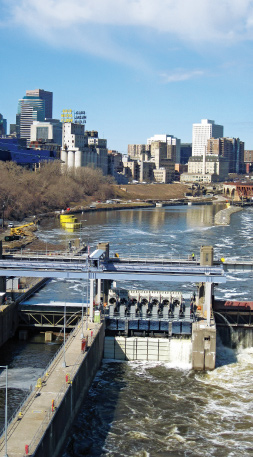
A low-head hydropower facility installed on an existing dam in Minneapolis turns the power of the Mississippi River into electricity. Photo courtesy of Brookfield Renewable Energy Partners L.P.
Small hydro systems have additional advantages. They are seen as less disruptive and more widely applicable than conventional hydropower facilities because water dropping less than 30 feet can turn their turbines, and installation does not dramatically change a river’s flow or create pools of water.
“The idea is to create more distributed generation,” says Trey Taylor, co-founder of the marine hydrokinetic firm Verdant Power. “When you think about it, most people live near water, in some form or another.”
And there’s power in that water.
Lock and Dam Hydro
Only 2,500 or so of the existing dams in the U.S. use the energy in flowing water to turn turbines that create electricity, leaving at least 54,000 (some suggest the number may be 80,000) unpowered, according to an April 2012 report by the NHA and the U.S. Department of Energy. The vast majority of dams, in fact, are used for navigation, irrigation, municipal water supplies and flood control. The Army Corps’ National Inventory of Dams of 2007 shows half of those nonproducing dams are at least 25 feet tall. By simply adding a smaller version of conventional turbines to the dams with the greatest potential, as much as 12 gigawatts of capacity could be installed, an amount equivalent to roughly 10 to 12 nuclear plants, according to the NHA’s report. The International Energy Agency, meanwhile, reports only 19 percent of hydro’s potential has been tapped, much of which can only be unlocked with low-head hydro.
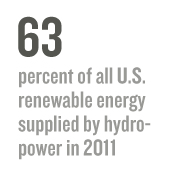 Low-head hydro operations have been around for decades, but the field is seeing a mild resurgence as improved technology makes capturing the power of moving water all that easier, as tax credits create opportunity and as interest in green energy grows. Filings from the Federal Energy Regulatory Commission, which vets all U.S. hydro projects, reveal that nearly every Army Corps lock and dam in the country has a hydro project proposed on it, ranging from 5 MW to more than 100 MW. FERC has issued more than 1,000 licenses for new hydro projects since 2007, and several hundred sit in the pre-filing-phase queue. Applying and getting a license is just one step toward building a plant, but the numbers seem to indicate a renewal interest in hydro.
Low-head hydro operations have been around for decades, but the field is seeing a mild resurgence as improved technology makes capturing the power of moving water all that easier, as tax credits create opportunity and as interest in green energy grows. Filings from the Federal Energy Regulatory Commission, which vets all U.S. hydro projects, reveal that nearly every Army Corps lock and dam in the country has a hydro project proposed on it, ranging from 5 MW to more than 100 MW. FERC has issued more than 1,000 licenses for new hydro projects since 2007, and several hundred sit in the pre-filing-phase queue. Applying and getting a license is just one step toward building a plant, but the numbers seem to indicate a renewal interest in hydro.
The agency even created an exemption from several aspects of the usual regulatory process for hydro of less than 5 MW. Jeff Wright, FERC’s energy projects office director, urged Congress last year to increase the exemption to 10 MW and to allow for a two-year, rather than three-year, application process.
“We need licensing requirements that are better coordinated and have a more predictable process,” says Jeanne Hilsinger, executive chairman and development director for the Czech Republic-based firm Mavel, a.s., and president of Mavel Americas, Inc., its Boston-based subsidiary. “It’s a very difficult process now, more difficult than it needs to be to protect the things [hydro opponents] want to protect.”
In fact, the environmental group Hydro Reform Coalition, which has fought to remove dams, sees little problem with the majority of proposals on locks. National coordinator Rupak Thapaliya says U.S. Army Corps locks “aren’t going anywhere” and seem good candidates for the addition of hydro. He says he hopes developers work to allow fish to safely pass through the dams, don’t damage water quality and stop filing proposals for hydro on unsafe dams, a issue he’s seen in some New England projects.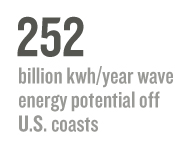
A 2010 Congressional Research Service report on small and low-head hydro suggests the environmental impact is minimal. Still, the report notes that “low-head hydropower development also has the potential to affect environmental components such as water quality, soils, and groundwater, as well as terrestrial and aquatic habitats and associated animals and plants, with the construction and operation phases of a project potentially affecting the local environment.”
Low-head Turbines
Low-head hydro developers install either vertical or horizontal turbines to capture waterpower. A vertical system brings water down into a turbine from above, similar to what happens in higher dams except that the height — the head — is much lower, as little as a showerhead in some circumstances. A horizontal system employs turbines located within a dam or lock that capture the moving water’s energy as it as it passes through. Spent water is discharged from the turbines through tailraces back into the river.
“It’s like capturing wind, except water is 840 times denser than air, so there’s more energy in water.” – Trey Taylor, co-founder of Verdant Power
The Kaplan turbine, the most popular low-head option, is manufactured mainly in Europe and uses axial flow technology. It has been around for decades. The $35 million Lower St. Anthony project represents a similar approach developed by Andritz, an Austrian manufacturer. Using the Andritz StrafloMatrix system, Brookfield installed 16 turbines stacked in eight modules in a gate adjacent to a lock. Energy is captured as water flows horizontally from the river through the turbines.
Although St. Anthony is among the first to use this Andritz low-head application, it is hardly new in other parts of the world.
“Europe is 10 years ahead of the U.S. on low-head power, probably 20 years,” Hilsinger says. “There’s so many low-head hydro sites in Europe that it’s seen as standard.”
Mavel is involved in five projects in the U.S., with two 10 MW dams on locks in Illinois and Des Plaines rivers near Joliet nearly complete. Developed by Northern Illinois Hydropower LLC, the installations will use Kaplan pit turbines that look like airplane propellers. While the projects are important to building Mavel’s brand, North America represents just 3 percent of the company’s business, far beneath Europe, South America and Asia, notes Hilsinger.
Beyond these turbines is the growing field of microturbines. These produce less than 1 MW per turbine — a level that hardly seemed worth the effort in the past — while offering a way to generate electricity in extremely low-head locations of only a few feet that may not need a great deal of power. In Kyoto, Japan, a Mavel microturbine produces 4.5 kilowatts of power, enough to light up a historic bridge and offer a green symbol in the city where the world’s leading climate accord was signed.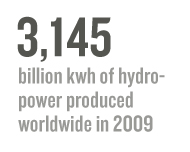
The Alameda, Calif.-based Natel Energy’s hydroEngine turbine produces energy with as little as 5 feet of drop, says Gia Schneider, the company’s founder. The hydroEngine can produce as much as half a megawatt and — like all microturbines — be installed in multiples to produce more power. For now Natel has had an installation producing nearly 1 MW in an Arizona irrigation canal and another underway in an irrigation canal in Oregon.
Underwater Wonders
The bottom of rivers and tidal areas are the next frontier for small hydro. Verdant’s marine hydrokinetic turbine employs underwater windmill-like turbines in arrays optimally configured to absorb the power of New York’s East River.
“It’s like capturing wind, except water is 840 times denser than air, so there’s more energy in water,” says Taylor. “The other beauty of water and water currents is reliability and predictability. It’s not intermittent, like wind — you don’t know when the wind will blow. Water, even the tides, is predictable.”
As of August 2012, FERC had issued 113 “preliminary” marine and hydrokinetic permits. Another 62 projects were in the “prefiling” license phase, many involving proposals on the Mississippi and other midwestern rivers filed by Free Flow Power and other energy companies.
Near Roosevelt Island in New York City, Verdant’s project is the first to receive a commercial license from FERC to produce tidal power. The turbines stand on pier-postlike structures drilled into bedrock in the east channel — the west channel handles all the shipping traffic. Located 6 to 8 feet below the river’s surface, the turbines turn at 35 revolutions per minute and change direction, like a weather vane, as the tide turns. Eventually the project will produce 1 MW of power, says Taylor, but the real opportunity “is 1,000 MW, for the Hudson River, Long Island Sound and upstate using this type of resource.”
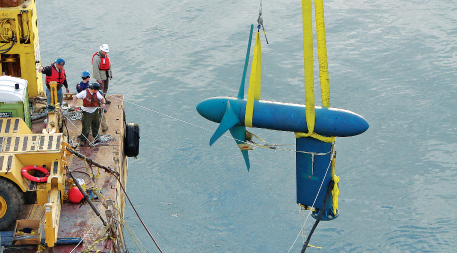
This turbine was installed in New York City’s East River in 2006 as part of the Roosevelt Island Tidal Energy Project — the first licensed commercial tidal power project in the U.S. Photo by Kris Unger/Verdant Power, Inc.
A different sort of hydrokinetic turbine is being tested in the Mississippi by Free Flow Power, which has proposed 65 marine hydrokinetic projects totaling 4 gigawatts. Free Flow’s innovation, which looks like a jet turbine and is at least 6 feet tall, captures energy as current flows through it at a nominal pace of 32 rpm, says Jon Guidroz, Free Flow’s project development director.
That requires the river to flow 7.2 feet per second, a speed capable of allowing the turbines to produce 40 kW, much less than traditional dam turbines. The idea, says Guidroz, is to install 5 to 10 MW of turbines per mile using a configuration of six turbines set up on pilings. Sets of turbines at 90-foot intervals could be put into place, ideally, in the southern section of the Mississippi where the river reaches a mile wide and more than 100 feet deep. Before long various stretches of the river would have the equivalent of an underwater wind farm, he suggests.
“When I think of hydro I think about community development. Anywhere in the world where you install hydro you will be building a community.” – Nelson Energy manager Bob Larson
In 2011 Free Flow tested a hydrokinetic turbine attached to a dock on the Mississippi in Louisiana owned by Dow Chemical Company. Engineers studied the energy generation level and ability of the turbine to withstand the rigors of a river often filled by branches, muck and other debris.
“We saw it perform in a real river environment and it was successful. We’re pleased with the power generation it produces,” Guidroz says.
Hydrokinetic experiments, however, have not always worked. HGE started testing a hydrokinetic turbine on a Mississippi lock and dam in Hastings, Minn., in 2009. Mark Stover, vice president of corporate affairs, says the turbine created power but wasn’t ready for prime time, forcing HGE to focus on a modular “plug and play” turbine it developed for locks and dams. That turbine can be installed next to a dam or downstream from it using an approach requiring less construction than a typical project.
“We were able to take the technology and development approach [at Hastings] and plug that into our low-head technology,” Stover says. “I’m not sure if we had not done Hastings that we would have seen the light on low head. There is a ton of potential low-head hydro in the United States that has not been developed for 20 or 30 years, and we’re going to go after it.”
A self-described “optimistic curmudgeon,” Nelson Energy manager Bob Larson sees hydro as a beneficial not only to energy balances but also to the economy as a whole. He notes that Minneapolis became a vibrant metropolis thanks to St. Anthony Falls, which was diverted in the 1800s to run sawmills and flour mills that produced the city’s original wealth.
“We’ve been a growing community for a long time because of hydro,” he says. “When I think of hydro I think about community development. Anywhere in the world where you install hydro you will be building a community.” ![]()
A version of this feature originally appeared in the Fall 2012 issue of Momentum magazine, Ensia’s predecessor.
Ensia shares solutions-focused stories free of charge through our online magazine and partner media. That means audiences around the world have ready access to stories that can — and do — help them shape a better future. If you value our work, please show your support today.
Yes, I'll support Ensia!